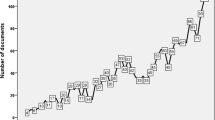Abstract
Introduction
Tularemia disease attracts attention as an important contagious zoonosis that has increased its impact in recent years. The aim of the study is to analyze the publications on tularemia between 1980 and 2020.
Methods
We performed literature retrieval in the Web of Science (WoS) on 22 September 2021. Search terms were “Francisella tularensis” and “Tularemia” in the article title for the period between January 1980 and December 2020. We determined the number of articles, keywords, countries, authors, and institutions for each publication. We visualized the data with the VOS viewer tool.
Results
After all inclusion and exclusion criteria were applied finally, 1688 articles were analyzed. The number of articles has increased in recent years. The three most productive countries in tularemia were the USA (777 articles 46.03%), Sweden (113 articles 6.69%), and Turkey (95 articles, 5.63%). Most of the articles were from the journal of Infection and Immunity (II), Plos one, Journal of Clinical Microbiology (JCM), Emerging Infectious Diseases (EID), and Vaccine. Sjostedt A. and Umea University—Sweden were the most influential author and institution.
Conclusions
Productivity trend has been shown to increase in tularemia. High-income countries had a great influence on the literature in the field. Publications from the USA were in a high percentage among all articles. Related work may lead to the future direction of this dossier in the next years.







Similar content being viewed by others
Data availability
Web of Science database.
Code availability
Not applicable.
References
Sjöstedt A. Tularemia: history, epidemiology, pathogen physiology, and clinical manifestations. Ann N Y Acad Sci. 2007;1105:1–29.
Maurin M, Gyuranecz M. Tularaemia: clinical aspects in Europe. Lancet Infect Dis. 2016;16:113–24.
Maurin M. Francisella tularensis as a potential agent of bioterrorism? Expert Rev Anti Infect Ther. 2015;13:141–4.
Oyston PC, Sjöstedt A, Titball RW. Tularaemia: bioterrorism defence renews interest in Francisella tularensis. Nat Rev Microbiol. 2004;2:967–78.
Centers for disease control and prevention (CDC) https://emergency.cdc.gov/agent/tularemia/facts.asp Accessed 16 Oct 2021.
Lester Rothfeldt LK, Jacobs RF, Wheeler JG, Weinstein S, Haselow DT. Variation in tularemia clinical manifestations—Arkansas, 2009–2013. In Open forum infectious diseases. 2017;4:1.
Akhvlediani N, Burjanadze I, Baliashvili D, Tushishvili T, Broladze M, Navdarashvili A, et al. Tularemia transmission to humans: a multifaceted surveillance approach. Epidemiol Infect. 2018;146:2139–45.
Mailles A, Vaillant V. 10 years of surveillance of human tularaemia in France. Eurosurveillance. 2014;19:20956.
Trevisanato SI. Did an epidemic of tularemia in ancient Egypt affect the course of world history? Med Hypotheses. 2004;63:905–10.
Eliasson H, Broman T, Forsman M, Bäck E. Tularemia: current epidemiology and disease management. Infect Dis Clin. 2006;20:289–311.
McEntire CR, Song KW, McInnis RP, Rhee JY, Young M, Williams E, et al. Neurologic manifestations of the world health organization’s list of pandemic and epidemic diseases. Front Neurol. 2021;12:161.
Dryselius R, Hjertqvist M, Mäkitalo S, Lindblom A, Lilja T, Eklöf D, et al. Large outbreak of tularaemia, central Sweden, July to September 2019. Eurosurveillance. 2019;24:1900603.
Oyston PC, Quarry JE. Tularemia vaccine: past, present and future. Antonie Van Leeuwenhoek. 2005;87:277–81.
Ogden NH, Artsob H, Margos G, Tsao J, Sonenshine DE, Roe M. Non-rickettsial tick-borne bacteria and the diseases they cause. Biology of ticks. 2011;2:278–312.
Bouchard L, Albertini M, Batista R, De Montigny J. Research on health inequalities: a bibliometric analysis (1966–2014). Soc Sci Med. 2015;141:100–8.
Guo Y, Hao Z, Zhao S, Gong J, Yang F. Artificial intelligence in health care: bibliometric analysis. J Med Internet Res. 2020;22:e18228.
Smith DR, Gehanno JF, Takahashi K. Bibliometric research in occupational health. Ind Health. 2008;46:519–22.
Zheng S, He A, Yu Y, Jiang L, Liang J, Wang P. Research trends and hotspots of health-related quality of life: a bibliometric analysis from 2000 to 2019. Health Qual Life Outcomes. 2021;19:1–13.
Li T, Ho YS, Li CY. Bibliometric analysis on global Parkinson’s disease research trends during 1991–2006. Neurosci Lett. 2008;441:248–52.
Liao J, Wang J, Liu Y, Li J, He Q, Jiang W, Dong Y. The most cited articles in coronary heart disease: a bibliometric analysis between 1970 and 2015. Int J Cardiol. 2016;222:1049–52.
Yang KL, Jin XY, Gao Y, Xie J, Liu M, Zhang JH, et al. Bibliometric analysis of researches on traditional Chinese medicine for coronavirus disease 2019 (COVID-19). Integrative medicine research. 2020;9: 100490.
Kocyigit BF, Akyol A. Bibliometric analysis of publication activity in the field of familial Mediterranean fever in 2010–2019: a Scopus-based study. Rheumatol Int. 2021;41:2015–23.
Akyol A, Kocyigit BF. Ankylosing spondylitis rehabilitation publications and the global productivity: a web of science-based bibliometric analysis (2000–2019). Rheumatol Int. 2021;41:2007–14.
https://datahelpdesk.worldbank.org/knowledgebase/articles/906519-world-bank-country-and-lending-groups Accessed 10 Apr 2022.
Kiraz M, Demir E. A bibliometric analysis of publications on spinal cord injury during 1980–2018. World neurosurgery. 2020;136:e504–13.
Sweileh WM. Global research trends of world health organization’s top eight emerging pathogens. Glob Health. 2017;13:1–19.
Demir E, Comba A. The evolution of celiac disease publications: a holistic approach with bibliometric analysis 2020. Irish J Med Sci. 1971;189:267–76.
Wu M, Wang Y, Yan C, Zhao Y. Study on subclinical hypothyroidism in pregnancy: a bibliometric analysis via citespace. J Matern Fetal Neonatal Med. 2022;35:556–67.
Funding
None.
Author information
Authors and Affiliations
Contributions
Both the authors contributed to the study conception and design. EK and HÜ wrote the manuscript. HÜ revised the initial manuscript. EK performed material preparation, data collection, and analysis. All the authors read and approved the final manuscript.
Corresponding author
Ethics declarations
Conflict of interest
None of the authors has any conflicts of interest to declare.
Ethical approval
The data in the study are in the public domain, so Ethics Committee approval was not required.
Consent to participate
Not applicable.
Research involving human participants and/or animals
This research does not involve human participants and/or animals.
Rights and permissions
About this article
Cite this article
Kaya, E., Üçer, H. Tularemia research activity: a bibliometric analysis between 1980 and 2020. Infection 50, 1507–1515 (2022). https://doi.org/10.1007/s15010-022-01837-4
Received:
Accepted:
Published:
Issue Date:
DOI: https://doi.org/10.1007/s15010-022-01837-4




